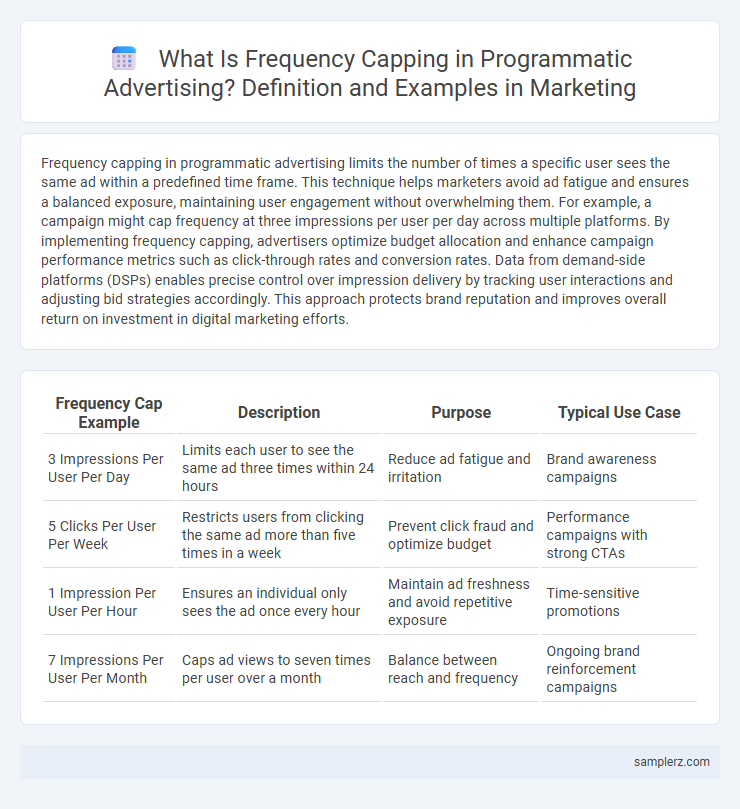Frequency capping in programmatic advertising limits the number of times a specific user sees the same ad within a predefined time frame. This technique helps marketers avoid ad fatigue and ensures a balanced exposure, maintaining user engagement without overwhelming them. For example, a campaign might cap frequency at three impressions per user per day across multiple platforms. By implementing frequency capping, advertisers optimize budget allocation and enhance campaign performance metrics such as click-through rates and conversion rates. Data from demand-side platforms (DSPs) enables precise control over impression delivery by tracking user interactions and adjusting bid strategies accordingly. This approach protects brand reputation and improves overall return on investment in digital marketing efforts.
Table of Comparison
| Frequency Cap Example | Description | Purpose | Typical Use Case |
|---|---|---|---|
| 3 Impressions Per User Per Day | Limits each user to see the same ad three times within 24 hours | Reduce ad fatigue and irritation | Brand awareness campaigns |
| 5 Clicks Per User Per Week | Restricts users from clicking the same ad more than five times in a week | Prevent click fraud and optimize budget | Performance campaigns with strong CTAs |
| 1 Impression Per User Per Hour | Ensures an individual only sees the ad once every hour | Maintain ad freshness and avoid repetitive exposure | Time-sensitive promotions |
| 7 Impressions Per User Per Month | Caps ad views to seven times per user over a month | Balance between reach and frequency | Ongoing brand reinforcement campaigns |
Understanding Frequency Capping in Programmatic Advertising
Frequency capping in programmatic advertising limits the number of times a specific user sees the same ad within a set timeframe to prevent ad fatigue and improve campaign effectiveness. For example, setting a cap at three impressions per user per day helps balance reach and engagement without overwhelming the audience. This control enhances ROI by optimizing ad exposure and maintaining brand recall without causing user annoyance.
Why Frequency Capping Matters for Marketers
Frequency capping in programmatic advertising limits the number of times a specific user sees the same ad, preventing oversaturation and ad fatigue. This optimization ensures higher engagement rates by maintaining ad relevance and improving return on ad spend (ROAS). Marketers benefit from enhanced brand perception and cost efficiency by strategically controlling ad exposure frequency.
Real-World Example: Frequency Capping in Display Campaigns
Frequency capping in programmatic display campaigns limits the number of times an individual user sees the same ad to prevent ad fatigue and improve user experience. For example, a campaign might set a cap of three impressions per user per day, ensuring that potential customers are not overwhelmed by repetitive ads. This approach increases engagement rates and optimizes budget allocation by targeting impressions more efficiently.
Frequency Capping in Video Advertising Scenarios
Frequency capping in video advertising limits the number of times a specific user sees the same video ad within a set timeframe, preventing ad fatigue and increasing campaign effectiveness. For instance, setting a frequency cap of three impressions per user per day ensures optimal reach without overwhelming viewers. This technique enhances user experience while maximizing return on ad spend (ROAS) in programmatic video campaigns.
Case Study: E-commerce Brand Using Frequency Capping
An e-commerce brand implemented frequency capping in its programmatic ad campaigns to limit ad impressions to three per user per day, resulting in a 25% increase in click-through rates and a 15% reduction in customer acquisition costs. By preventing ad fatigue, the brand maintained higher engagement levels and optimized budget allocation across digital channels. This case study highlights frequency capping as an effective strategy to enhance user experience and maximize ROI in programmatic advertising.
How Frequency Capping Optimizes Ad Spend
Frequency capping in programmatic advertising limits the number of times a specific user sees the same ad, preventing redundant impressions and reducing wasted ad spend. By controlling ad exposure, advertisers enhance campaign efficiency, ensuring budget allocation targets unique users more effectively. This approach maximizes return on investment (ROI) by minimizing ad fatigue and increasing engagement rates.
Best Practices for Implementing Frequency Capping
Frequency capping in programmatic advertising limits the number of times a user sees the same ad, enhancing campaign efficiency and reducing ad fatigue. Best practices include setting caps based on user behavior data, adjusting limits according to campaign goals, and continuously monitoring performance metrics like click-through rates and conversion rates. Implementing dynamic frequency capping ensures optimal ad exposure without overwhelming the audience, improving overall engagement and ROI.
Frequency Capping and User Experience: Concrete Examples
Frequency capping limits the number of times a user sees the same ad within a set period, enhancing user experience by preventing ad fatigue and annoyance. For instance, a fashion retailer using programmatic ads might cap exposure to three impressions per user per day, ensuring relevance without oversaturation. This approach maintains engagement and boosts ad effectiveness by delivering personalized content without overwhelming the audience.
Measuring the Impact of Frequency Capping in Programmatic Ads
Measuring the impact of frequency capping in programmatic ads involves analyzing metrics such as click-through rates (CTR), conversion rates, and return on ad spend (ROAS) to determine optimal ad exposure limits. By controlling how often a user sees an ad, frequency capping reduces ad fatigue and improves audience engagement, resulting in higher campaign efficiency. Advanced analytics platforms track user behavior and attribute performance changes directly to frequency capping settings for precise optimization.
Frequency Capping Pitfalls: Lessons from Failed Campaigns
Frequency capping in programmatic advertising prevents ad fatigue by limiting how often a user sees the same ad, but incorrect settings can reduce campaign effectiveness. In a failed campaign by a major retail brand, overly aggressive frequency caps resulted in insufficient ad exposure, undermining brand recall and sales conversion. Marketers must balance cap thresholds to optimize reach without overwhelming users, avoiding pitfalls like underexposure that stifle campaign performance.

example of frequency capping in programmatic ad Infographic
 samplerz.com
samplerz.com